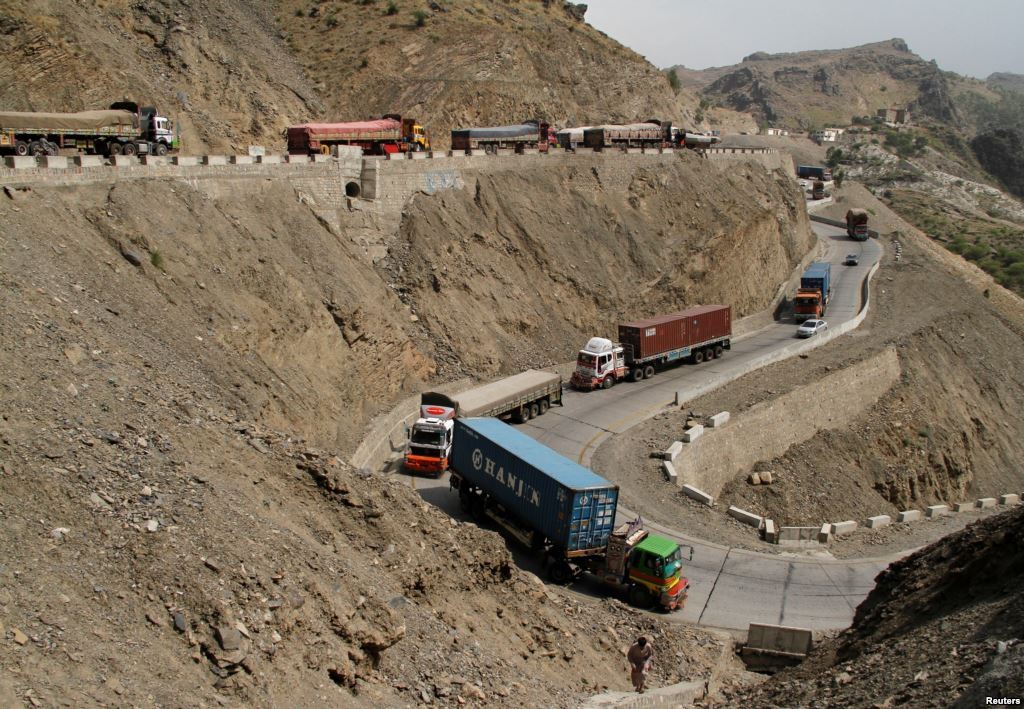
Prospects of trade between Pakistan and Afghanistan are dim

Thousands of trucks of non-perishable and perishable goods got stuck on both sides of the border between Pakistan and Afghanistan due to the face-off. Only briefly after the border clashes, around 500 trade cargo containers and trucks, according to the Customs authorities, were allowed to cross the border.
According to data received from the Model Customs Collectorate (MCC) and Pakistan Afghanistan Joint Chamber of Commerce and Industry (PAJCCI) trade between Pakistan and Afghanistan increased substantially till 2013. During the seven years, from 2007 to 2013, the volume of trade increased from $83 million in 2007, to $2.38 billion in FY2013. This steady growth encouraged the two sides to take the bilateral trade to $5 billion in 2015.
However, Pakistan’s exports to Afghanistan have decreased alarmingly during the current financial year. Mutual trade between the two countries has also plummeted considerably. Pakistan, as Afghanistan’s principal supplier of goods, is still keeping the trade balance in its favour.
The recent increase in Afghanistan’s exports, increase in smuggling across the border and decline in Pakistan’s exports have set alarm bells ringing for Pakistan. Pakistan’s exports to Afghanistan have decreased in the last five years and Afghanistan has now fallen to the 6th from 2nd biggest export destination for Pakistan in 2011.
Collector MCC Peshawar, Qurban Ali Khan, while sharing the trade data, informs that the total fall in bilateral trade, decline in Pakistani exports and a surge in imports from that country is a big concern.
During the last fiscal (2014-15), according to him, about 40,194 trucks of different perishable and non-perishable goods crossed into Pakistan, while imports during the 11 months (July 1 to May 31) of the current fiscal (2015-16) were 44,454 trucks. Similarly, in exports, 1,69,605 trucks dropped to 1,38,485 trucks that crossed the border during the 11 months of the current fiscal.
The value of the goods exported to Afghanistan also decreased by 27 per cent as during July to May 2015 the goods exported to Afghanistan valued at Rs147.717 billion, while exports during the 11 months of the current fiscal stood at Rs115.784 billion.
However, the data shared by Khan, reveals that revenue collection in respect of taxes on at least ten items imported during the last 11 months including, grapes, tomatoes, apricots, onion, mineral coal, re-meltable scrap, scrapped auto parts, raw cotton, re-rollable scrap and aluminum scrap, etc, increased to Rs6.28 billion from Rs4.0 billion collected in 2014-15 fiscal.
Exports through Torkham and Kharlachi in Kurram Agency registered a sharp decline during the current fiscal.
Only the export of fresh fruit of Kino has risen from Rs4.7 billion to the Rs5.6 billion during the current financial year through Torkham, while medicines’ exports through Kurram increased from Rs75 million to Rs237 million. However, the overall medicines’ export also started falling after the Afghan government blacklisted some Pakistani pharmaceutical companies a few months ago.
The fall in Pakistan’s exports is intriguing at a time when Afghanistan’s total annual imports have been on the rise.
One reason for decline in Pakistan’s exports to Afghanistan could be the rise of informal trade across the border. A trader, who wished not to be named, highlighted how Afghan markets are flooded with Pakistani products, such as cloth and readymade garments, livestock, poultry, poplar and other items, but the same is not visible in official data.
Similarly, according to a customs official, around Rs500 million Afghan goods are daily smuggled through only one tribal agency of Khyber that comes to $1.8 billion of the informal trade. Most of these items are imported to Afghanistan through transit trade arrangement.
Another reason could be the increase of Iran’s exports to Afghanistan. Pakistani cement exports constituted more than 12 per cent of total Pakistani exports to Afghanistan in FY12. They decreased to 11 per cent in 2013. That means competition will remain intense in the coming months.
Traders believe trade financing facilities are very poor between Afghanistan and Pakistan which has become an obstacle for the Afghan importers, who largely operate informally.
However, Khan claims that most of the tariff related issues, such as bank statement, letter of credit (LC) and insurance guarantees have been resolved and the exporters have been allowed to open their LCs in the local currency.
The Collector also dispels the impression that the recent border stand-off will have any impact on the trade between the two countries in the long run. He says after the computerisation of customs operation and border management Pak-Afghan trade will be further formalised.
The decline, he says, started months before the standoff began, and that power supply to the local industry, shortfall in the cotton production, etc, also led to the situation.
Pakistani trader and businessman, Muhammad Ishaq, member Khyber Pakhtunkhwa Board of Investment and Trade (KPBOIT) believes some tariff and non-tariff barriers (NTBs) are responsible for decline in exports to Afghanistan. Ishaq says the Afghan government had imposed 25 per cent duty on Pakistani exports which is discriminatory.
Read also: Editorial
He believes the incentives given to the Indian and Iranian exporters also contributed to the rise of their exports. Afghanistan has imposed zero duty on the Indian goods and only 5 per cent on the Chinese items that has created a favourable environment for their exports, Ishaq says.
President Khyber Pakhtunkhwa Chamber of Commerce and Industry (KPCCI), Zulfiqar Ali Khan, terms the incapacity of the Commerce and other ministries as one of the major reasons for decline in the Pak-Afghan trade over the last two years. He says the local manufacturing sector has collapsed due to heavy duties, taxes and non-availability of infrastructure and electricity.